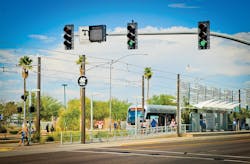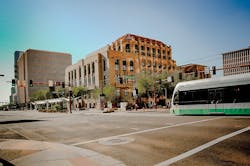Clear signal ahead
Light-rail vehicles operate in an exclusive right-of-way adjacent to vehicular traffic, except at intersections where they operate on shared right-of-way controlled by signals.
Residents of the Valley of the Sun account for more than 4.5 million of the state’s 6.8 million population. Phoenix itself has more than 1.5 million people, making it the sixth-largest city in the nation. When suburban sprawl began to force commuters to drive nearly an hour each way between work and home, city planners decided to change the way they handled mass transit.
Valley Metro Rail currently operates 26 miles of light rail connecting the cities of Phoenix, Tempe and Mesa. The alignment is on a grid network of surface streets with coordinated signal operation. The light-rail vehicles operate in an exclusive right-of-way adjacent to vehicular traffic, except at intersections where they operate on shared right-of-way controlled by traffic signals.
A complex intersection management system was devised to ensure competitive transit travel time without degrading vehicular travel time beyond acceptable levels. This was achieved by making transit vehicles a priority at signalized intersections.
Upon opening the initial 20 miles of light rail in December 2008, approximately 150 intersections in the three cities were rebuilt and their operations modified. Before light rail, each city had a variety of communication media at its intersections, including twisted pair, fiber optic and T1 telephone systems. The result of the light-rail project was the development of a redundant fiber optic-based communication system connecting all cities.
Planning it out
In order to develop an implementation plan, an evaluation of traffic-signal controller hardware and software systems was conducted for operation of priority control by light rail. These included NEMA-based systems using transit-priority software and 2070-based systems using more advanced software specifically designed for light rail. The study modeled a section of the alignment using VISSIM for both signal control types. The comparison evaluated to see how well the priority control worked and whether traffic showed proper flow. The 2070-based system was selected due to its overall performance.
However, even though the 2070 controller had the capability to replicate the predictive priority control, it was incompatible with the existing NEMA signal controllers and the central systems at the traffic operations centers for the cities. Therefore, a new hardware system had to be developed.
Consequently, Valley Metro and its city partners developed a system with an ASC/3 controller by Econolite, fitted with a 2070-1B card by Siemens. This card is typically plugged into an ATC controller. At the time of design, all three cities wanted this type of functionality and the same touch and feel system-wide for their maintenance staff.
It was difficult having two competing companies work together, but it was required because there were 150 controllers needing installation. Those within the project also viewed this as an interesting experiment. There was some code Econolite and Siemens ended up sharing with each other. After completion, both companies were praised for their innovation and partnership. Version 1.7.5C of the software was installed during construction and within two years and many rounds of testing later, version 1.7.6E was implemented. That version of the software is still in use today within the boundaries of the city of Phoenix.
Valley Metro Rail transit center at Sycamore and Main Street in Mesa, Ariz.
Predictive priority
Once the hardware was installed, a comprehensive traffic-signal control strategy was developed. This “predictive priority” allows the train to get a green signal at intersections based on systematic tracking of the vehicle using a series of advanced detectors embedded in the trackway. The signal controller then has the ability to provide an early green or a green extension for the transit phase, or to adjust the phase split time.
The signal controller decision is based on estimated train arrival at the intersection. This was the only method evaluated that allowed trains to operate through signalized intersection crossings with acceptable light-rail travel times and minimizing vehicular delay in all directions, while also maintaining coordination within the traffic-signal system.
The signal controllers were connected to each other through a peer-to-peer communications network. Train arrival information was communicated to several intersections downstream, giving those controllers enough time to adjust phase splits by predicting the arrival of the light-rail vehicles at the intersection. This phasing allows only small portions of time to be adjusted so that it does not interfere unacceptably with cross-street traffic or pedestrian movements.
The signal prediction for the next intersection is based on the maximum speed within the Valley Metro system, which is 35 mph on city streets. The call is delayed in a few areas due to long distances between stations or accounting for station stops that occur between intersections.
Keeping comms open
Communications between intersections was the key element for the successful implementation of a predictive priority system. Consequently, a backbone gigabit Ethernet network was devised. This network was designed as a distributive network. Unlike a network with only central computing capabilities, a central system failure will not cause the entire system to stop working.
With distributive control, the traffic controllers manage the operations of that intersection based on the input from adjacent intersections regarding train location, speed and projected arrival time. However, the system can still be managed from a central traffic management center as needed.
The network’s design consisted of six to eight controllers per channel to form a daisy-chain network. The controllers at the end of the chain were connected to different mid-level switches to create a self-healing network. Controllers were then able to talk to each other with a digital handshake, even across city boundaries.
During commissioning, the municipalities decided to change the network architecture. Separate, but communicating networks were requested and required splitting the network into two sub-networks using a router. The router allowed seamless communication between field-level devices, yet restricted control and monitoring to the central systems of the respective cities only. This resulted in a more efficiently managed network with protection from excess Ethernet traffic.
A hierarchy also was created in the system to allow intersections to talk to each other and to the central system, creating redundancy. In case an intersection’s transmission is broken, the signal from one intersection can go to the mid-level switch and back down to the other intersection. With fiber optics, it only takes milliseconds to complete the path and the latency is negligible.
Valley Metro Rail transit center at Jefferson and 1st Avenue in Phoenix.
Success in development
Prior to controller installation, a traffic-signal test facility was set up so all equipment could be configured. The operation was conducted in an old Jo-Ann Fabrics store set for demolition to be part of a park-and-ride for the transit system. For those involved, it was nice to have an air-conditioned building to test the equipment, which is better than being outside and exposed to the extreme summer heat in Arizona.
The tests included hardware, firmware and communications equipment. Ethernet cords were placed in between controllers so maintenance personnel could practice communications networking during training. Each traffic-signal controller was custom programmed for the intersection where it would eventually operate. This included setting up the signal timings for all the controllers and implementing priority control settings for each.
A detailed technology transfer program was developed for the traffic-signal operations and maintenance personnel of the three cities. The program included additional classroom sessions on the hardware and firmware used in the controllers and weekly hands-on training sessions at the test center. This program helped the personnel manage the steep learning curve in adopting the new system. It is impossible to determine how much post-startup, in-the-field evaluation time was alleviated by utilizing this facility.
Once testing was completed, all signal controllers were turned over to the cities. Valley Metro does not maintain any of the 200 signals in the system.
Timothy Neal, a traffic engineer with the city of Phoenix and a lead on intersection management during light rail’s construction, took what he learned during development at the testing center and implemented it. The city of Phoenix signal shop now houses a staff of 69 electricians and technicians to support the 136 light-rail transit intersections and the remaining 1,000 signals within the city. Based on the success of the test facility, the signal shop set up a test bed with six controller cabinets, which is used on a regular basis to test any changes to the control strategies or timings for the predictive priority system.
The key to making the system run smoothly was all the work done after revenue service began. Despite producing what seemed to be a very effective network upon conclusion of construction, each and every intersection needed to be evaluated for efficiency.
“We had 116 signals to get done in the city of Phoenix alone,” Neal said. “There’s probably not a single signal that we didn’t change something, after the system got up and going.”
Once revenue service started, Phoenix came up with a city standard unique for the transit light-rail signal phasings—everything was either going east or west along the alignment, regardless of actual train direction. This standardized the train phases as phase 2 and 6 in all controllers. Once that was set, every intersection was reconfigured, which took almost 18 months to complete.
From 2008-2010 upgrades were implemented to help Phoenix drivers as they seemed to be confused on the one-way couplets. Red arrows were installed at protected intersections, but drivers did not realize turns were not allowed on this indication. All arrows were changed to traditional ball signals and “no-turn-on-red” signs were installed. When light-rail vehicles approach, the intersection goes all red for vehicles and conflicting pedestrian movements. That was a big change and accidents were reduced.
Another key for Phoenix to stay current with its operations has been the contracts it developed with Siemens. During the first five-year contract, Phoenix technicians upgraded their way down the line and Siemens would come in to evaluate the data. Thereafter, the contract was not renewed after that initial five years because the predictive priority platform was stable and there were sufficient spares of ASC/3 controllers with the 2070-1B cards available.
However, as the spares have been depleted, Siemens has since been brought back under contract to evaluate its predictive priority software installed in the current M60 controller to see if a single manufacturer system could be deployed as a direct replacement for the current Econolite ASC/3 controller. This gives Phoenix a path forward until such time that a new contract is issued for the next generation of controllers.
The current software and hardware are 10 years old, which can be considered outdated in technological terms even though everything is functioning properly. When Valley Metro Rail expands with several new extensions planned through 2025, the idea is to acquire and install the latest updates for those projects followed by retrofitting that new software into the existing line. This task will be gigantic in terms of scope and finances, but it will ensure the Valley Metro Rail system will operate as smooth as any transit system in the country.


